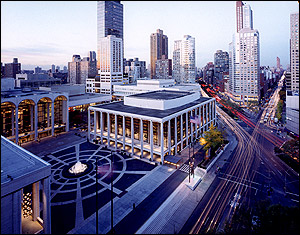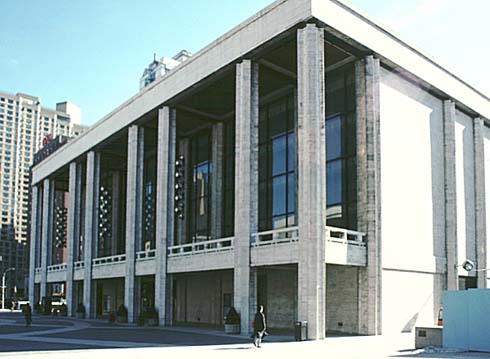
Posted on 04/23/2006 1:53:04 PM PDT by Republicanprofessor
Have you ever been to Lincoln Center in New York? I had never been there until yesterday, when I was privileged enough to attend an opera at the Met. Although the opera was wonderful, I dare say I was even more impressed with the architecture of the entire center. It seems to me to be the epitome of modern architecture of the second phase of the International Style (that simplified skyscraper style with often-elegant materials, steel beams, and glass). In fact, the beauty and style of Lincoln Center could be said to rival the music created within.

I had always thought, from pictures, that the Center looked cold and barren. How wrong I was! The subtleties of the International Style II cannot be appreciated from distant photographs. Like minimal sculpture of the same period in the sixties, the experience of the viewer completes the aesthetic experience: for as we wander through the complex, the variations in shape, space, and texture enliven our experiences as human beings.
It was wisely laid out, by Wallace Harrison, of Harrison and Abramovitz, off to the side of Columbus Ave.: between west 62nd and west 66th Streets and Columbus and Amsterdam Avenues. A secondary street rises beside it, perfect for buses to cough up their passengers. The steps to climb set off the plaza still further and are more emphatic in photographs than when actually approaching the plaza.

To the left is the New York Opera, designed by Philip Johnson in 1962. This is the center for ballet and musical theater. To the right is Avery Fisher Hall, originally Philharmonic Hall, designed by Max Abramovitz in 1962. Straight ahead, taller and marked by elegant frontal barrel vaults, rises the Metropolitan Opera House from 1965. This is the first such cluster of concert halls designed for one location; it seems to me that they to reflect Michelangelo’s design for the Campidoglio in Rome. Michelangelo had unusual, acute angles with which to work, but Lincoln Center is wisely laid out at right angles, angles echoed in the columns affronting each building.


Like Michelangelo’s Senator’s Palace, the Met is definitely the pinnacle of Lincoln Center: due to its curved barrel vaults and to its greater height and central location. And its interior shines in comparison to the other buildings. We had time to kill before the opera and strolled to explore the lateral buildings. The ceilings on their lower floors were low, with openings on either side, where one could visit the cafeteria, the gift shop, and have access to the more open lobbies above. We did not visit the halls themselves, but noting the images on the web, the lobby in each was an effective contrast to the open, swirling experience of the auditoriums.


The New York State Theater, where ballet and musical theater is produced, designed by Philip Johnson. 

Avery Fisher Hall, formerly Philharmonic Hall, designed by Abramovitz.
The columns outside the buildings could easily be overlooked, but these forms subtly and beautifully enhanced the elegance of the ensemble. The columns of Symphony Hall on the right curved up and outwards in a most unique fashion. The travertine marble was reminiscent of the work of Mies van der Rohe, the king of the first International Style.



The cross shape of the columns of the New York State Theater remind me of Mies’ elegant steel crossed columns used in works like the Barcelona Pavilion from 1929, shown on the right above. Although Lincoln Center is most elegant, it does lack Mies' meticulous attention to detail was. This is probably best seen in the transition between the barrel vaults of the Met's building and the marble columns which was rather rough and awkward. (See above.) But this was one of the few details lacking elegance.
The interior of the Met was the most elegant of all: a full, sweeping double staircase that was reminiscent of the Paris Opera House. No low ceilings here; the space opened up in supreme curving elegance. Above, four levels of balconies rose above the main curves of the staircase, a perfect spot from which to gaze during intermissions. A restaurant presided on one side in the full open space. Smaller rooms were tucked into the sides, and restrooms were also tucked into the main body of the building (almost invisibly). The curved, mysterious suspension of the staircase was as magical and musical as the operas within. They say that architecture is the frozen music of the arts, and one could almost hear the strains of Mozart’s melodies in the sweeping forms.

Inside the auditorium, strong design continued to reign. The seven rows of seats in the five different balconies are steeply placed, so that one’s head is never in the way. There is a steep descent from row G to row A, from which one can see the gold circles of the ceiling design radiating outward. Ingeniously tucked into these gold shells are the lights for the stage. Cozy boxes line the sides of the theater. Perhaps the only clunky design here is on either side of the stage, where a dull gold cross design hardly echoes the elegance radiating elsewhere in the theater. (This may be only evident in person; in this photo it looks lovely.)


As we were leaving, my son remarked that the chandelier was now lit. This sunburst of a chandelier, descending several stories, is most unique. I realized how often the images of Lincoln Center are taken at night. Perhaps this is the first complex of buildings ever designed with electric lights in mind. The glass enclosed spaces are at their most elegant glowing of night, promising the elegance of the entertainment realized within.


I'm so outdated.
Thanks for the update. I had seen the Tully images when I was doing a search for images but I had not found the facts of the update that you posted.
Thanks.
Thanks for the ping. Interesting.
A great place, and thank you for reminding this old New Yorker of a favorite place of mine.
BTW, O'Neill's across the street is a nice place to eat.
Are you aware that the street used in the movie version of "West Side Story" was eliminated to make room for Lincoln Center?
Other good articles on Lincoln center can be found in this forum. Lately there seems to be a backlash at the renovation plans for the North Campus. The reflecting pool is gorgeous as is. I would not mind seeing the huge overhead bridge on 65th taken down. I think the other Diller Scofido designs for AlicE Tully Hall are too out of place and detract from the overall masterplan, which although nnot flawless, is decent.
http://www.wirednewyork.com/forum/showthread.php?t=3547&highlight=lincoln+center

You can see a small piece of the old building in the lower right.
Unfortunately, styles change all too quickly in our country, and I think especially quickly in Los Angeles. Thus they felt the International Style out of date in the 1980's and updated the LA County Museum with the new Postmodern style, which now looks bulky, ugly, and dated.
I think 50 years is usually the dangerous time. When a work of architecture is about 50 years old, it is apt to be too dated and in danger of being torn down. But if one would wait another 50 years, it would have been heralded as a fine antique of its era.
In Europe, works are not old until they are closer to 500 years old, and there is less random tearing down and rebuilding according to temporary fashion.
I should probably visit the LA County Museum of Art before pronouncing such qualities as ugly, etc. I don't know when I'll next get to the Left Coast, however.
I was at the Lincoln Center on Saturday night to see Carmen!!
We probably passed each other in the crowds. :)
Unfortunately, much of the architecture was obscured by all the rain so I appreciate this timely post.
I did get to spend a few hours at the Metropolitan Museum of Art on Saturday afternoon. I really only had time to see some of the French Impressionists. I will have to go back to spend more time there, that's for sure.
Carmen is also a wonderful opera!
It was very frustrating to be in NYC and not see any museums. I really want to see the David Smith retrospective at the Guggenheim. But we'll see if we can make another trip soon.
I had never been to the opera before so I think I picked a good one to start with. I really enjoyed it.
I'm glad I could squeeze in some time at the Metropolitan Museum of Art. But, of course, now I want to go back and spend much more time there.
Ironically, the LACMA bought the old May Co. building a block away for expansion space. It is a wonderful Art Deco style building of '30s vintage, and has been restored.

Disclaimer: Opinions posted on Free Republic are those of the individual posters and do not necessarily represent the opinion of Free Republic or its management. All materials posted herein are protected by copyright law and the exemption for fair use of copyrighted works.